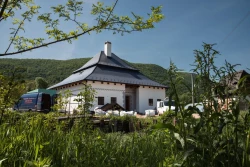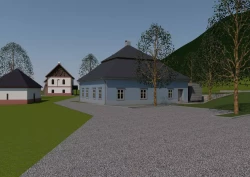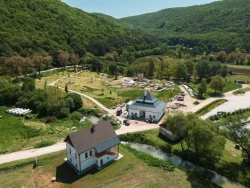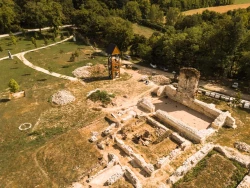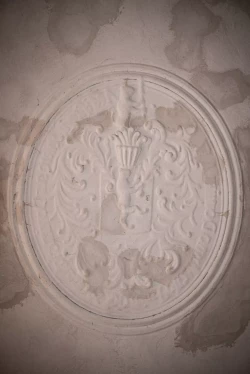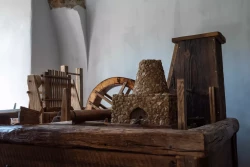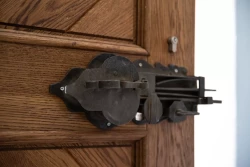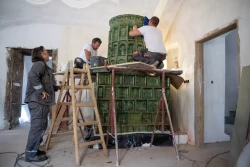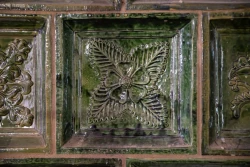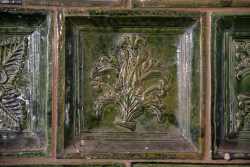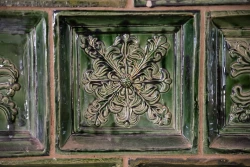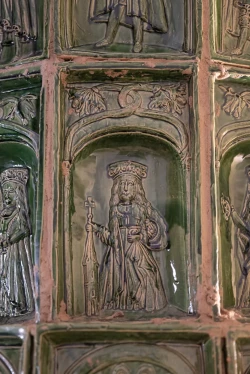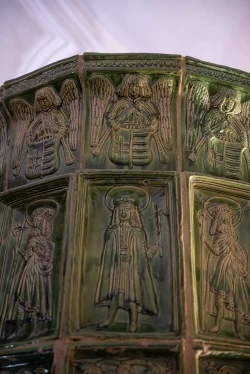Gombaszög
We can find the fortified monastery of Gombaszög (Gombasek) 11 km southwest of Rozsnyó, in the former county of Gömör, on the Slovakian side of the Aggtelek Karst, between Szalóc and Vígtelke, behind the Andrássy mansion which is presently being renovated by the Sine Metu association. Gombaszög was the northernmost Pauline center in historical Hungary. It was a very rich and important place in its time.
Location: https://tinyurl.com/56vsvhap
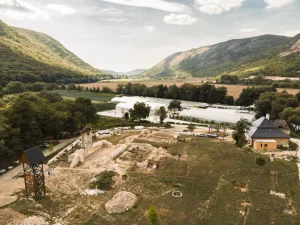
Photo: Fábián Gergely
The settlement near Szalóc on the banks of the Sajó River was founded by the Ákos Clan. The area is mentioned as a notable place in the border records of 1243. Its name was mentioned for the first time in 1371, but it was probably settled at the beginning of the 14th century to protect the nearby ferry. It was one of the settlements founded under German law.
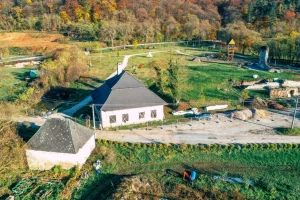
Photo: Fábián Gergely
In the last period of the monastery’s existence, according to historical sources, the building was fortified. The village of Gombaszög (also known as Havasalja), settled by the Ákos clan, was founded under the hill of Zavaz in the early 14th century. Nearby, the members of the related Bebek and Csetneki families founded a Pauline monastery in honor of the Virgin Mary in 1371, which belonged to the Diocese of Esztergom.

Gombaszög
Photo: Orosz ÖrsWe can read the following inscription on the tombstone of Bebek György:
“Hic iacet Georgius Bubek magister tavernicorum regalium qui fecit extruere ecclesiam beate virginis fratribus heremitis ordinis sancti Pauli primi heremite anno domini MCCCLXXI.” Meaning:
“Here rests Master Royal Treasurer Bebek György, who built the Church of the Immaculate Virgin Mary for the first hermit, the hermit friars of the Order of St Paul.”

Now, in 2025, at last, the founder’s gravestone is finally where he was buried. May God rest the greatest medieval lord of Gömör County, the great diplomat who twice visited the Pope on behalf of King Louis the Great, and to whom we owe the unique Gömör fresco treasure.


The chosen site, where two streams meet and flow into a narrow plain in the middle of the Sajó Valley, was ideal for the development of fish ponds and mill sites. The monastery prospered economically in the 14th and 15th centuries and received considerable donations from its natural resources. These were mainly various vineyards in the counties of Gömör, Torna, and Borsod, in the relative vicinity of the monastery.

Photo: Orosz Örs
The monks sold their wines at the fairs in Rosznyó and Csetnek. The size of the income is clearly shown by the fact that in the second half of the 15th century, the Pauline monks of Gombaszög stopped waiting for new donations and started buying estates themselves. At first, Gombaszög belonged to Diósgyőr Monastery, but in the middle of the 15th century, it became independent and even took over the administration of some other monasteries. Among the latter were Háromhegy in Martony and Újház in Felsónyárád.

In the turbulent times after the Battle of Mohács (1526) the life of the local Pauline community changed considerably. The patron of the monastery, which belonged to the Bebek family, was Imre Bebek, prelate of Székesfehérvár, who initially supported Gombaszög following the family tradition.

However, in 1533 he decided to cast fifty cannons in Rozsnyó. He got the raw material for it from the bells he had forcibly taken from the churches of Gömör. The following year Bebek Imre converted to the Reformed faith and got married. The pilgrims of Gombaszög defended themselves against the threat by taking their most important valuables to the citizens of Rozsnyó. However, Bebek Ferenc broke into Rozsnyó and plundered its citizens, robbing them of their possessions, which were kept in the house of the poet Jakab.

We know that Bebek defeated the Habsburg troops in 1556 with the help of Ottoman auxiliaries. However, he was fighting against the Turks just two years after this. The Turks captured him in 1560 and brought him to Constantinapolis for treason. He managed to return home only as an ally of the Turks, and he plundered the area around his headquarters, Szádvár Castle. He tried to get hold of the lands in the region.

In 1566, Bebek György and his men attacked the monastery, plundered it, and subjected the remaining captured monks to mental and physical torture. After that monastic life was never restored in Gombaszög. The monastery was later transformed into a fortress by Bebek, which was captured and destroyed by Lazarus of Schwendi, a general of King Maximilian around the turn of 1566/1567.

Bebek György died in 1567, and the family’s line of Pelsőc was discontinued.
The excavation of the monastery
For centuries before research began, only an 8-meter-high wall stump marked the site of the former monastery. The carved elements of a masonry window on either side of the stump were still a clue to the building’s architectural importance. The overgrown bushes around the ruins were cleared by the Bástya Egyesület (Bastion Association) of Rimaszombat in 2006. It was how the southern lines of the building became visible.

The first archaeological excavation of the Pauline Monastery of Gombaszög was carried out in 2011 by Peter Tajkov, who conducted a trial excavation to check the extent of the church and the thickness of the layers.
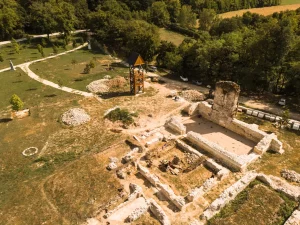
All they have discovered so far is that it was a heavily disturbed building, once richly painted. Research has focused exclusively on the church. According to the excavation report, the walls that are not visible on the surface are significant, and the quality and quantity of the remains of the mural paintings are outstanding.
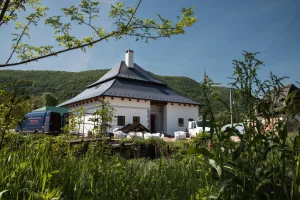
In 2017, the SINE METU Association managed to purchase a part of the ruins and the Andrássy mansion that had come to private ownership in 1989. In April 2018, a systematic research of the monastery church was started on behalf of the Sine Metu Civic Association. The research was organized by the Gömör-Kishonti Museum in Rimaszombat and Eötvös Loránd University in Budapest, led by Alexander Botos and Mordovin Maxim, with the participation of Szakálos Éva from the Balassi Bálint Museum in Esztergom. As a first step of the systematic excavation, which took place in April and May 2018, the entire surviving church of the monastery was brought to light.
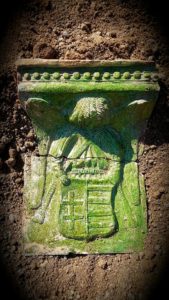
Dr. Páll Dávid Gergely (Faculty of Science and Computer Science, University of Szeged) carried out a geophysical survey of the unexplored parts of the monastery using georadar and antenna. Significant remains of the walls were hidden under the modern surface, but they were subject to severe disturbances in the past.

In the end, two sites were restored to a presentable state: the church and the walls to the west and south of it. As far as the building complex is concerned, it is clear that a single-nave church with a polygonal sanctuary was built at Gombaszög in the late 14th century. A coin of King Zsigmond (1287-147) found in the mortar of the walls testifies to the date of construction. The building, with a ribbed cross vault, stood alone, initially without a cloister.

The carved frame entrance opened in the middle of the western facade. The south side of the church was divided by four buttresses, and the two eastern windows are still half visible on the 7-meter-high wall. The church was originally vaulted (as indicated by the four buttresses on the south side). The main entrance of the church, with its modestly framed portal, opened to the west. The most serious disturbance was to the sanctuary.

It is not yet clear how the entire eastern part of the complex, including the rising walls of the triumphal arch, was destroyed, but the destruction certainly affected the foundations, and the wooden foundations were excavated. Nevertheless, the plan and size of the sanctuary can be reconstructed from the small fragments that remain (e.g. vaulted corner lintels), small wall stumps, and analogies from the 14th century.

The 11.19 m long nave (interior dimensions: 16.5 x 8.85 m) was connected to a sanctuary that could be reconstructed to 8.8 m. The entire interior of the church was covered with brick floors, and some of the square panels were decorated. The building was richly painted. Different wall paintings covered the walls, the vault, and even the capstones.
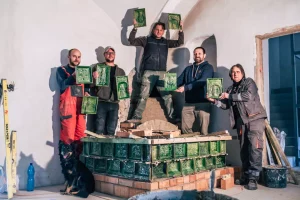
Two restorers, Peter Korefi and Juraj Gregorek, excavated and conserved the seemingly unsalvageable murals, which were discovered in April 2018 and had been underground for more than 500 years. The most beautiful find is the keystone of the eastern part of the nave, depicting the blessed hand of the Lord.

In the spring of 2018, a carved, fragmentary capstone was excavated at a depth of about 180 cm. It is a miracle that the 14th-century carved stone, which fell from a height of 10 meters and crumbled to the floor of the church, survived the fall and the centuries intact.

After the sculptural work, where the broken parts were replaced with the original material, the fresco was restored by the restorer Peter Koreh. The artifact was stored in the Gömör-Kishonti Museum in Rimaszombat. The archaeological work continued in 2019.

Photo: Orosz Örs
First, a stove tile with a COA from a workshop in northern Hungary around 1500 was discovered, and then other tiles depicting King László, Prince Imre, Saint Paul, or the patron saints of miners, Borbála and Katalin, were unearthed. The excavation also uncovered a medieval entrance to the courtyard of the Pauline Monastery, where early modern coins were found, presumably left by the Bebek family, who left behind counterfeit coins that are now of considerable value. Candlesticks from the 15th century, cannonballs from the 15th and 16th centuries and four mortar shells from the Second World War were also unearthed a few meters from the ruins.
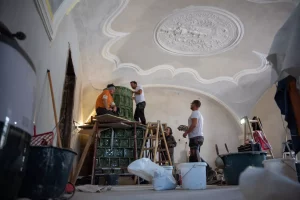
In April 2019, what was thought to be a 16th-century cannon tower (defense tower) attached to the southwestern end of the enclosure wall turned out to be a much earlier, medieval octagonal cemetery chapel. Perhaps the greatest discovery was finding the remains of the famous tiled oven. In the fall of 2020, frescoes were uncovered, and preserved in its base. Bebek György was likely buried in this octagonal chapel.

In 2021, the archeologists led by Kamil Svana discovered the apsis of the shrine and the well of the monastery. All of the excavations were helped by Balogh Zoltán, the archeologist technician of the Technical University of Kassa (Kosice).
Here is a video with English subtitles:
In addition to the organization of the Gombaszög festival, the excavation and conservation of the Pauline Monastery is also carried out by the association SINE METU. After six seasons of excavation, a museum has been opened. The exhibition “The treasure is buried there” in the renovated Andrássy Mansion will give you a deep insight into the past of the monastery. It is an outstanding exhibition in the whole of Slovakia.
Gombaszög around 1550, a video from Orosz Örs: created by Szabó Krisztián, architect, and Dr. Daniel Bešina of the University of Nyitra (Nitra)
Sources: Alexander Botot – Mordovin Maxim: Régészeti kutatások a gombaszögi pálos kolostorban. Várak, kastélyok, templomok 2018. aug. 17-21. o.; Karczag Ákos-Szabó Tibor: Felvidék és Kárpátalja erődített helyei. Budapest, 2018. II 1078-1080.

You can support the Sine Metu on their website: https://www.sinemetu.kadbudapest.hu/
Dear Readers, I can only make this content available through small donations or by selling my books or T-shirts:
Please, feel free to support me with a coffee here:
You can check out my books on Amazon or Draft2Digital, they are available in hardcover, paperback, or ebook:
https://www.amazon.com/dp/198020490X or at https://books2read.com/b/boYd81

My work can also be followed and supported on Patreon: Become a Patron!http://Become a Patron!
[wpedon id=”9140″]

https://hungarianottomanwars.myspreadshop.com/all
Here are many more pictures of the Monastery of Gombaszög and the Andrássy Mansion:





